Commercial stands are fine, but for a lot of shooters a homemade target stand is fun project to work on away from the range, plus one that can save you money.
Recently, I updated my flashlight review protocols. One of the things I wanted to include were photos of the flashlights’ beam at night. For scale, I decided to illuminate a target at a known distance. For that, I needed a target stand. Rather than buy a commercial product, I decided to build my own portable target stand.
There are a lot of DIY hobbyists in the gun world. I’m one of them, and since you are reading this, I’m betting you are as well.
I documented my building effort and put together my notes into these plans for you to use if you like.
My total cost for parts was $34.40. Anyone with some of the parts lying around can do this even cheaper. My total time for construction was about two hours. You will likely do it in half the time because you won’t be stopping along the way to photograph and document your work.
- Preparation
- Assembly of the Stand
- Step 1 – Cut PVC Pipe to 16" Lengths
- Step 2 – Seal Four Ends with Test Caps
- Step 3 – Assemble Rear Base Legs
- Step 4 – Assemble Front Base Section
- Step 5 – Complete Assembly of Base
- Step 6 – Cement Uprights to Tees
- Step 7 – Assemble Upright Section
- Step 8 – Complete Assembly of Target Stand
- Step 9 – Finishing and Use
- Cheaper Assembly Option
- Final Thoughts
Preparation
As with any project, preparation can save you time later. I’ve put together a list of parts and tools you will need to build one of the stands I describe.
Parts List
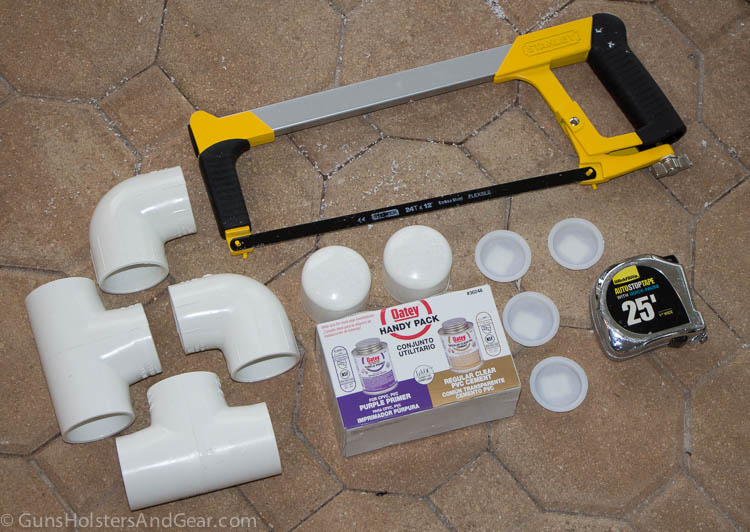
The following are the parts you will need to make the target stand I describe. To make things simple, I put together a PDF you can download to take with you to Home Depot, Lowes or wherever you do your shopping.
Here are the parts you need and the prices I paid for them locally at my Home Depot:
| Item | QTY | Price |
| 1.5: PVC pip, 10′ | 1 | $3.80 ea |
| 1.5″ PVC pipe. 2′ | 1 | $3.65 ea |
| 1.5″ PVC T-joint | 4 | $2.23 ea |
| 1.5″ PVC 90-degree elbow | 2 | $1.72 ea |
| 1.5″ PVC cap | 2 | $0.98 ea |
| 1.5″ PVC test cap | 4 | $0.58 ea |
| 1″x2″x8′ furring strips | 2 | $0.96 ea |
| PVC cement | 1 | $8.39 ea |
Click here to download the list to take with you to the store.
You will also need something to fill the PVC base with to weight it down. Dirt or sand out of your backyard will work, so don’t feel like you need to pick up self-leveling cement on your parts run.
Tools
Many people will have these tools on hand already. If you do not, don’t fret – they are relatively inexpensive. Here is what I used:
- measuring tape
- Sharpie marker
- hack saw (or specialized PVC pipe cutter)
- hand trowel/spade
General Cautions
Any time you use hand tools, chemicals or venture outside of your home, you run the risk of being injured. Exercise common sense and be careful. If you think anything I suggest is unsafe – don’t do it.
PVC cement and primer are chemicals that can be dangerous. Read the label and follow the instructions.
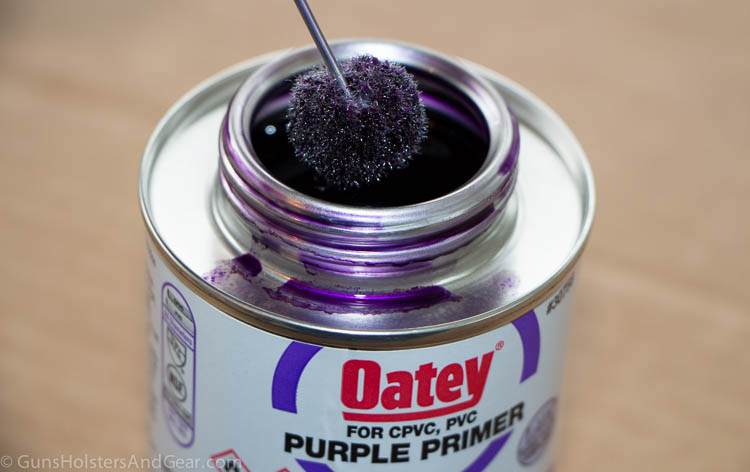
Another word of caution about PVC primer: it is purple and stains everything (including a pool deck – don’t ask me how I know.) Don’t work with this stuff over your carpet. I suggest taking things outside and working over old cardboard or something similar. Gloves aren’t a bad idea either.
Assembly of the Stand
I’ve arranged the steps in what I think are the easiest order. Some of you might see a better way. By all means modify these steps as appropriate and share your thoughts in the comments section at the end of this article.
Step 1 – Cut PVC Pipe to 16″ Lengths
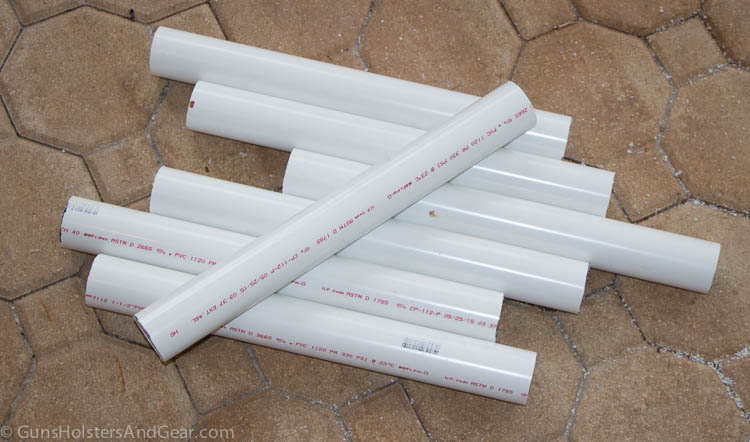
a. Using the measuring tape and Sharpie, mark off 16″ lengths on the 10′ and 2′ sections of PVC pipe.
b. Cut the pipe using the hacksaw or other tool. You should have eight 16″ sections of PVC pipe. Discard the scrap pieces.
Step 2 – Seal Four Ends with Test Caps
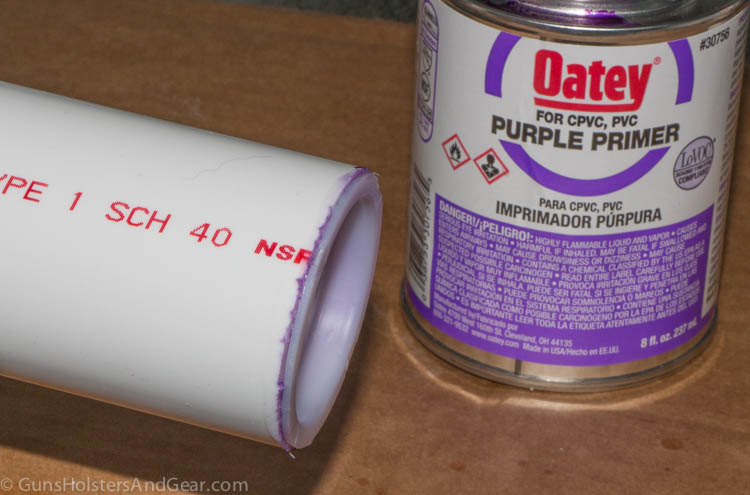
Take four of the PVC pipe sections and seal one end of each with the PVC cement and test caps. Follow the instructions of the PVC cement and be careful to not let it drip down your arm or onto anything valuable.
Step 3 – Assemble Rear Base Legs
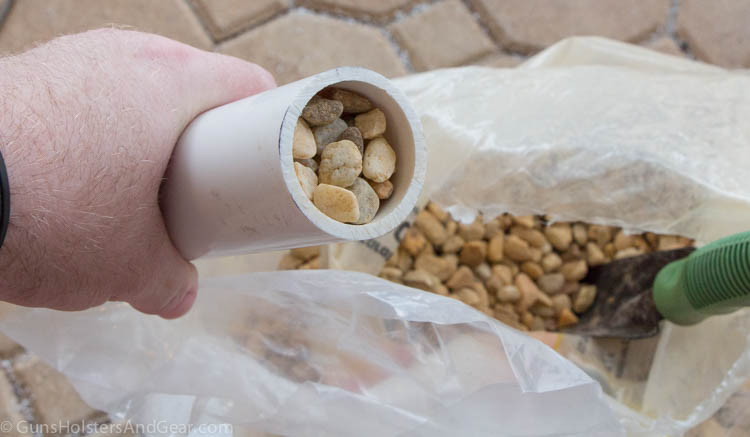
a. Take two of the sealed PVC pipe sections and fill the pipe with your ballast material. As mentioned above, this can be dirt, sand or virtually anything heavy. The pipe will be sealed, so don’t worry about the material leaking out.
For my target stand, I used pea gravel that I had on hand from another project. If that had not been on hand, I would have used wet sand from the back yard.
Make sure that the test caps are set before loading the ballast material in the pipe. You do not want them coming loose.
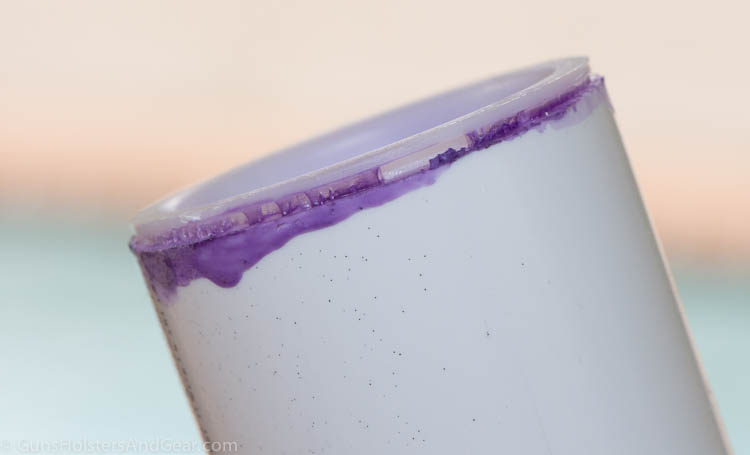
b. When the material is loaded in the pipe, seal the open end of each with the PVC caps and cement.
Step 4 – Assemble Front Base Section
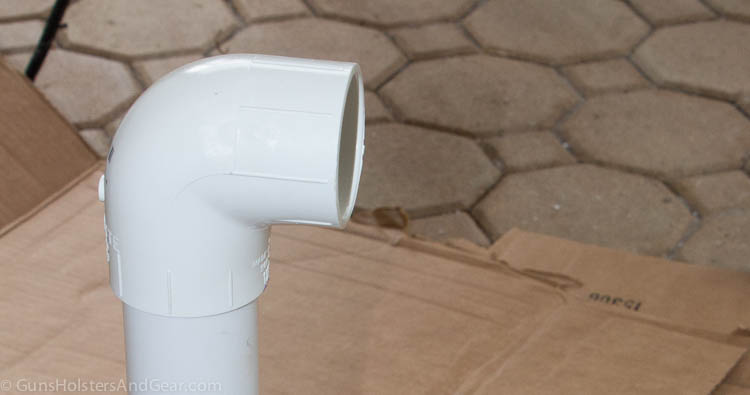
a. Take the other two PVC pipe sections with the test caps affixed and fill them with the ballast material. Then cement a 90-degree elbow to each of them.
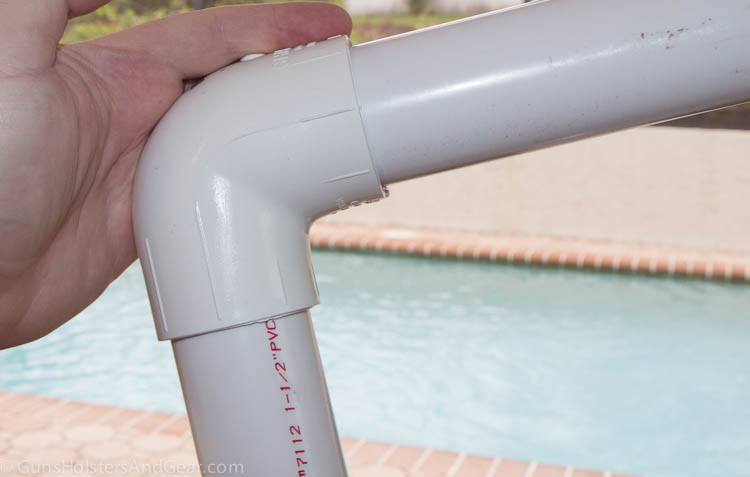
b. Take one of the unsealed PVC pipe sections and cement it into the open end of one of the elbows.
c. Fill the pipe with the ballast material.
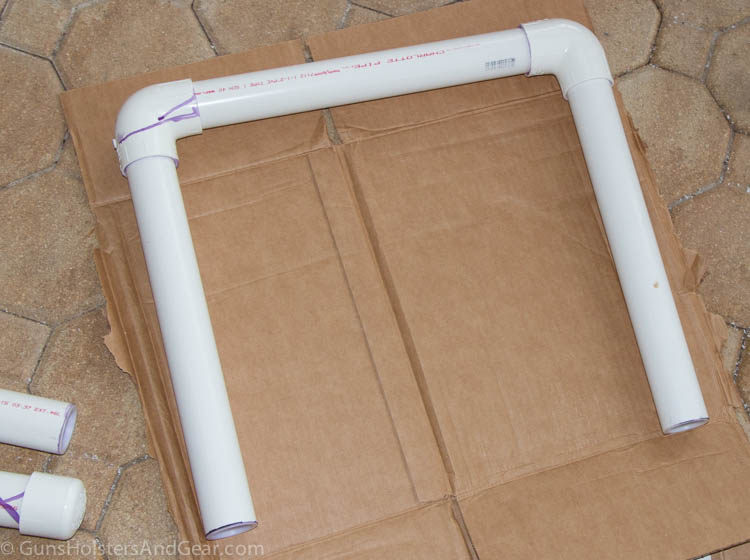
d. Cement the open end of this pipe to the open end of the remaining open elbow. This will complete the front part of the base section, and it should resemble three sides of a square.
Step 5 – Complete Assembly of Base
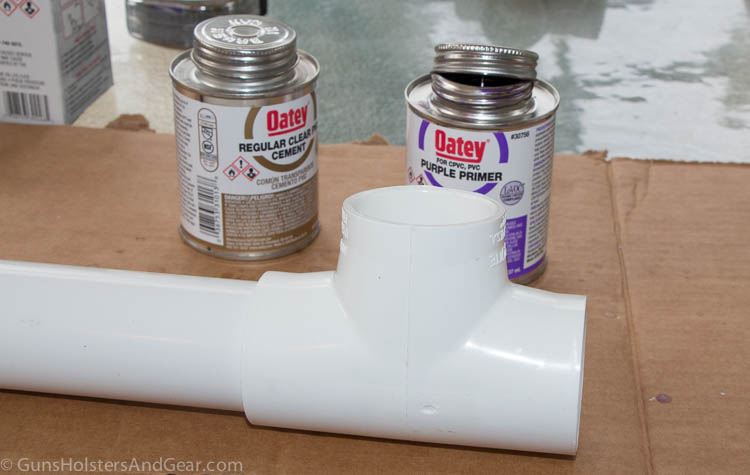
a. Cement one tee joint to each end of the front base section.
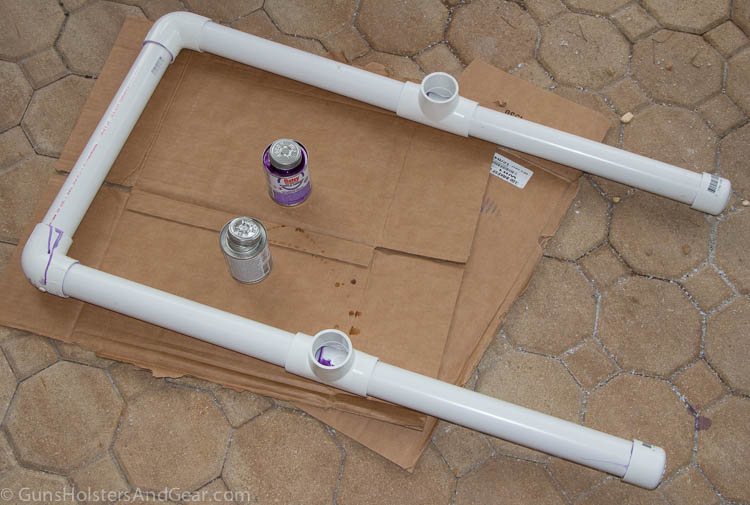
b. Cement the rear base legs into the open ports of the tee that are parallel with the front base section. This will complete the base section assembly.
Step 6 – Cement Uprights to Tees
Cement one of the unused PVC sections into one of the main outlets of an unused tee joint. Repeat for another PVC pipe section and the remaining tee.
Step 7 – Assemble Upright Section
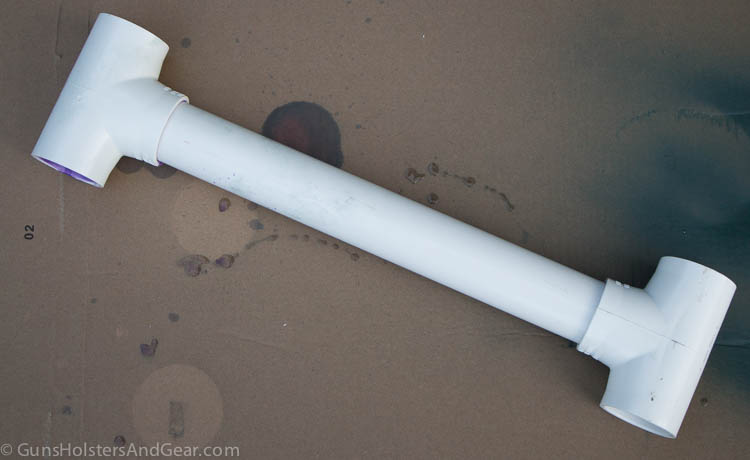
a. Cement the remaining PVC pipe section into one of the 90-degree outlets of the tee joints from Step 6.
b. Ensuring that all of the pipes will be on the same plane, cement the open end of the PVC pipe section in Step 7a to the remaining open 90-degree outlet from Step 6.
Step 8 – Complete Assembly of Target Stand
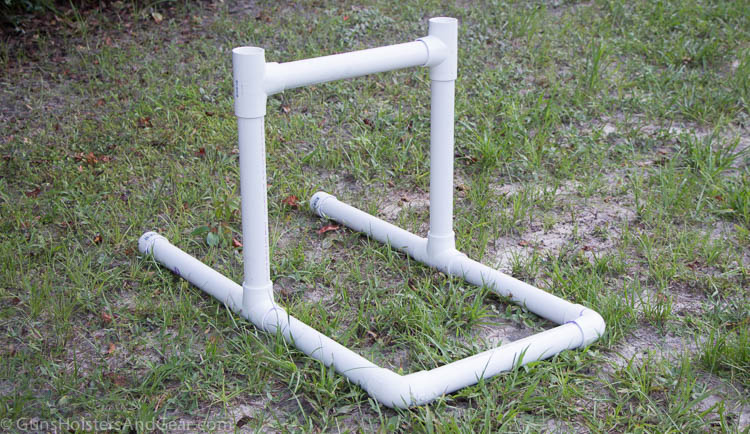
Slide the upright section from Step 7 into the base section. The target stand is now read for use.
If the stand is going to be used at a permanent location, the upright assembly can be cemented into the base. However, if this is going to be a portable target stand, do not cement the uprights into the base.
Without being cemented into the base, the uprights can be removed for more compact storage and transportation.
Step 9 – Finishing and Use
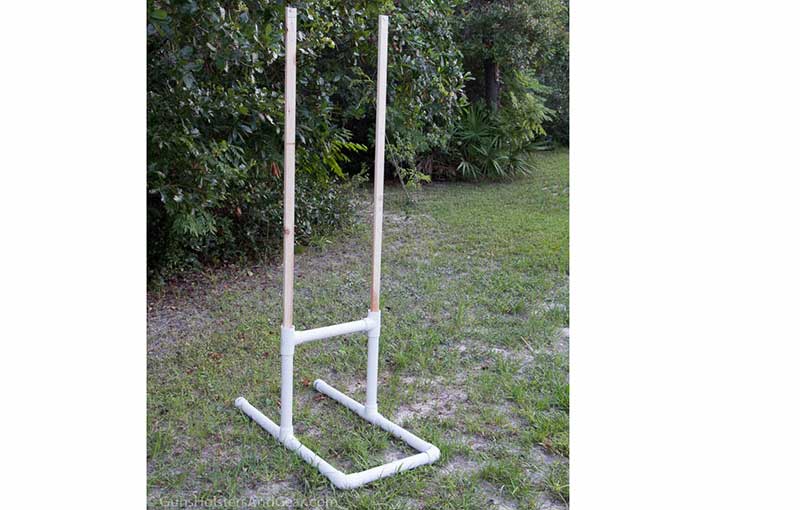
Insert the furring strips into the uprights. Targets and cardboard backers can be attached directly to these strips. If the strips are hit by a stray bullet, they are easy and cheap to replace.
The furring strips will be snug in the uprights. I find this helps to prevent them from swaying. You may want/need a rubber mallet to tap them into place.
I cut the furring strips to a 6′ length to approximate the average height of a man. You can cut them shorter or leave them long to meet your needs.
White PVC doesn’t bother me, but applying spray paint is an option. You definitely want to use a spray paint that is specifically designed for plastics, otherwise you can expect a lot of chipping in short order. Sanding and stripping off the pipe printing is a good idea (a great guide on this is here.)
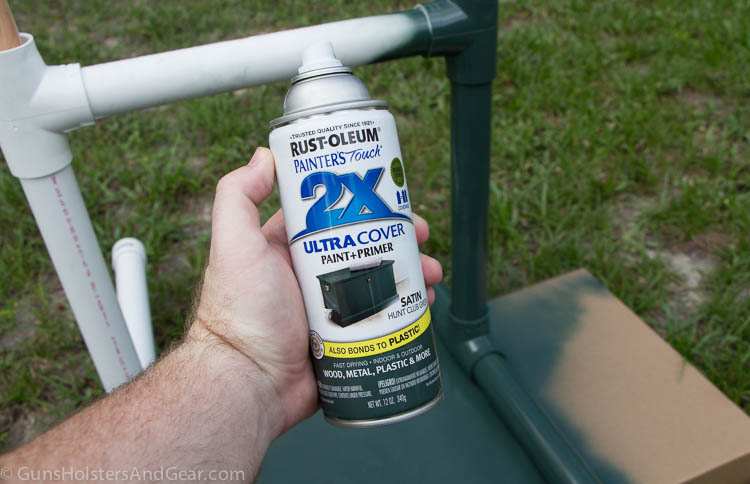
I used Rust-Oleum Painter’s Touch 2x Ultra Cover that includes a primer and paint on my stand. I did not sand the PVC, and the paint held good on the pipe plus completely covered all of the printing. I paid $3.87 for a single can of the paint. There was more than enough in a single can to do a single coat on two target stands.
Cheaper Assembly Option
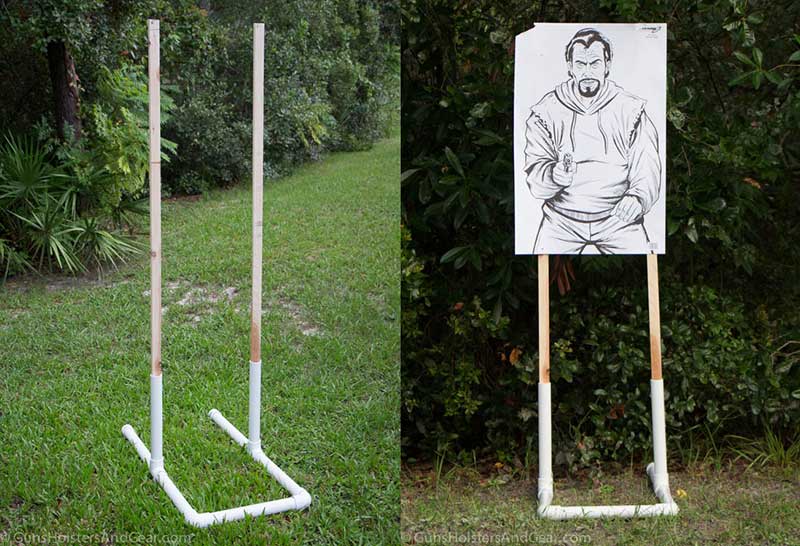
For a less expensive version of this stand, delete two of the tees and the extra 2′ section of PVC. Then when assembling the target stand, do not make a cross bar support for the upright section. This will still be sturdy enough for most people and will save you about $8.11 and bring the parts price down to $26.29. I prefer to have the cross bar support, but it may not be important to you.
Final Thoughts
I hope this has been helpful to you. There are a lot of different ways you can make a home made target stand, and using PVC like I have done is just one of them.
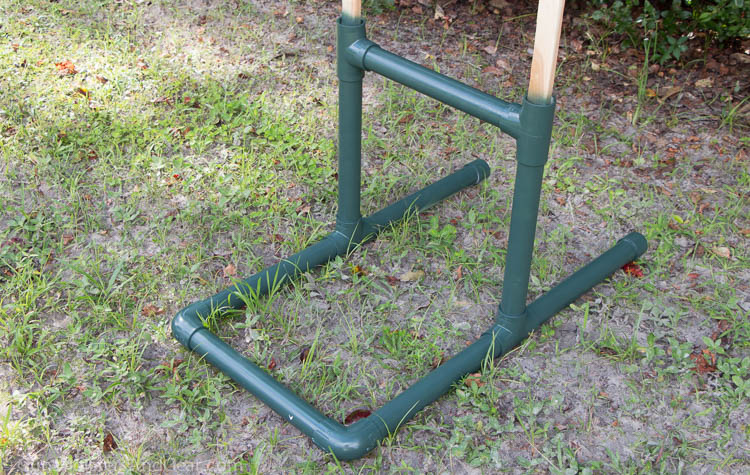
If you have any thoughts on how I can improve these plans, please let me know in the comments section below. I want to make sure that every shooter has a chance to have a quality stand without breaking the bank on parts or losing their mind on convoluted instructions.
Disclosure
GunsHolstersAndGear.com is an independent, for-profit website. I do not charge readers a dime to access the information I provide.
Some of the links on this page and site are affiliate links to companies like Amazon and Palmetto State Armory. These links take you to the products mentioned in the article. Should you decide to purchase something from one of those companies, I make a small commission.
The links do not change your purchase price. I do not get to see what any individual purchases.
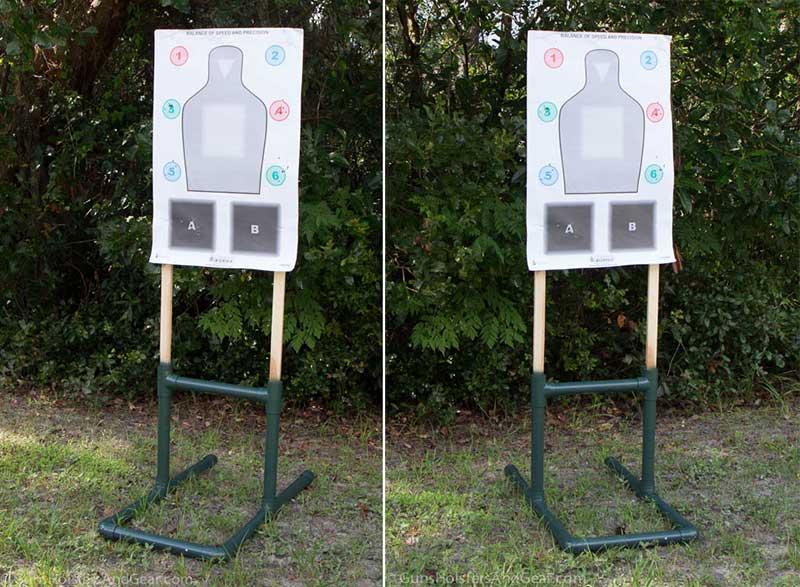
71 replies on “How to Build a PVC Target Stand”
It is a good plan and the stand works well, including the ability to replace parts when needed. I chose not to load the pipe with an ballast material as I don’t think the stand will stand up to even a moderate wind with a giant cardboard sail attached. So, I am committed to adding three sandbags to the mix and carry them with the stand to the range. The sandbags are going to be necessary anyhow so I use them and they pin the frame down firmly. I am a retired police officer and one of our range officers a few years back to decided to make a version of these stands for convenience at semi annual department wide qualifications. Sadly theY took a terrible beating during the course of the day but he anticipated that and had spare PVC parts to keep the range moving. Every year the midnight shift outshot everyone, followed b y 4-12 and the daytime chairborne rangers could not hit anything. The female radio operators out shot them and they don’t even carry. This is a good idea and I hope others use these and shoot often., Punching holes in paper is not that hard but when rounds are coming back at you skills go to hell, unless you practice. HAPPY SHOOTING!
I modified your measurements to 15†pieces which only requires the single 10’ section and it turned out great. Can’t wait to get out and start using it.
Thanks a lot for publishing this. I got the material for two stands a couple of years ago, but didn’t get around to building them until today. They were a snap to build, and I can’t wait to get out to my sister-in-law’s farm to try them out. Nice design.
Hi Chris,
I’m glad this was useful for you. I’ve gotten a lot of use out of mine.
-Richard
I just finished building your target stand. It was so easy to do – especially for a girl! 🙂 My only question is where to find targets big enough to fit the span of the strips. Or do you make your own? I put up a large piece of card stock and attached my targets to that using binder clips (at the top) and scotch tape on the bottom. This works well but would be cumbersome to do in the field. Do you have a source for large paper targets?
Thanks
Hi Polly,
Thanks for your feedback! I’m glad the instructions were helpful.
I usually use large targets like those used for law enforcement qualifications. But you can use cardboard from old boxes to make a backer and use smaller targets if you like. If you already have a lot of smaller targets, that is probably the best way to go. It’s not elegant, but it gets the job done.
Action Targets is one of the largest target makers and they have a wide range of full-size targets here: https://shop.actiontarget.com/prodcat/papercardboard.asp Action offers a wide range of target choices including photorealistic ones. These should all fit the target stand easily. Just bring a sample gun and attach them directly to the wood strips.
However, Action targets can actually be purchased cheaper from third party vendors. I purchase from Optics Planet here: http://shrsl.com/2aasw
For transparency, that is an affiliate link where I earn a small commission if you buy anything after using it. However, I don’t recommend companies that I don’t do business with already. Optics Planet offers a much better price than Action and I’ve always gotten good service from them.
I hope this helps!
Richard
Polly – if you have a building supply store like Lowe’s or Home Depot near you, they carry several types of plywood or formed panel products. All of which will eventually break down in the elements outside, but you can get several shooting sessions rounds, maybe dozens, out of anything from 1/4″ plywood, hardboard, or OSB sheathing. Most of these places will cut them down to your sizing for free, and they often have reduced pricing pieces that have been damaged in transit or handling that you can get rather cheap. Just attach to the 1×2’s with a few 3/4″-1″ wood screws. Keep in mind, this makes the unit top heavy, so added weight at the bottom or in the pipe base is a plus.